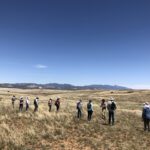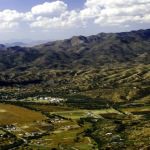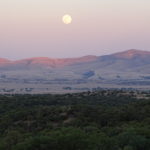
Oct 6, 2016 | Blog
Imagine a little-known national treasure — a largely wild land home to ocelots, exotic and imperiled birds like elegant trogons and Mexican spotted owls, imperiled reptiles and amphibians like the threatened Chiricuahua leopard frog, and El Jefe, the only jaguar currently living in the United States. This is the Mountain Empire of southern Arizona, a place as special as Yosemite or Yellowstone, and worthy of international recognition. Extending across the border into northern Sonora, Mexico, this region is bounded by mountains that rise from the flat desert floor to touch the sky. With one of the richest concentrations of biodiversity in the U.S., the Mountain Empire is a sanctuary for imperiled species. But even a sanctuary can be threatened.

Mountain Empire, © Thunderforest
Refuges in the Sky
One reason the Mountain Empire has so many rare and unique species is the rugged sky island mountain ranges. Each range, like the iconic Santa Rita Mountains, south of Tucson, stands alone surrounded by desert flatlands like an island in the sea, with mountains so tall that they span climate zones from hot, dry desert to moist forests at higher altitudes. Together, these characteristics give the mountains their nicknames of “sky islands.” For many species, the sky islands are refuges where human impacts have been relatively small. Streams rise from the rocks, nurturing rare fish, frogs, snakes, and nesting habitat for birds like threatened yellow-billed cuckoos, southwestern willow fly catchers and hummingbirds.

Western yellow-billed cuckoo, © Creed Clayton/USFWS
There are so many hummingbird species in the Mountain Empire that the Tucson Audubon Society founded the Paton Hummingbird Center, dedicated to conserving hummingbirds and other local biodiversity.
Birders visit from countries around the world for the chance to see so many species in one place. One of Defenders’ board members, Dr. Ron Pulliam, works with the Mountain Empire group Borderlands Restoration to restore the plants that hummingbirds, bees, butterflies, and moths need along Harshaw and Sonoita Creeks in the Patagonia Mountains. The globally imperiled Patagonia eyed silk moth, once widespread in native grasslands, is now making its last U.S. stand in the Patagonia Mountains. The threatened southwestern willow flycatcher, once common near Tucson in now-vanished gallery forest along the Santa Cruz River, is today found higher up in riparian vegetation along still-flowing mountain streams.
One of the gems of the Mountain Empire is the Las Cienegas National Conservation Area: 45,000 acres of rolling grasslands, oak-studded hills, along with the Cienegas Creek wetlands. This is home to the world’s largest population of endangered Gila topminnow and other federally threatened and endangered fish, frogs and snakes. Las Cienegas provides a vital corridor of protected lands that connects the Santa Rita and Whetstone sky islands.
The most revered animal in the Mountain Empire is El Jefe, a powerful male jaguar. Video of him prowling along a stream in the Santa Rita Mountains recently went viral, with at least 20 million viewers. He and other jaguars and ocelots most likely came north to the U.S. from Sonora, Mexico in the past decade, travelling along sky island mountain corridors with little human activity.

Jaguar, © Barry Draper
Threats to the Empire
Sadly, as much healthy habitat as there is in this region, there’s also a problem: Industrial mining. The Mountain Empire is riddled with old abandoned mines and grandiose plans for new ones. As you can imagine, mining has a massive impact on an ecosystem, from the land itself, to the noise that can scare wildlife away, to the traffic that would come in and out of the mining project. And perhaps most importantly, there’s the water.
Throughout the Southwest, so much groundwater has been pumped for agriculture, industry, and towns and cities that water tables have dropped and streams and ponds have dried up, desiccating wildlife habitat in a land already parched. This is why so many water-dependent species have vanished, or are threatened or endangered. In Arizona, 20 of 35 surviving native fish species are endangered and one is already extinct. Mining presents yet another threat to the water supply, using up billions of gallons of groundwater over the course of years, and often contaminating it with pollutants.
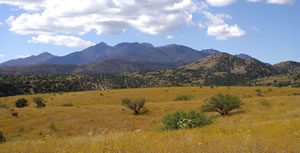
Santa Rita Mts, © Larry Jones/USFS
The diversity of the “sacred” Santa Rita Mountains in the Coronado National Forest is threatened by mining interests.
The giant open-pit Rosemont Mine is planned for the Mountain Empire’s Santa Rita Mountains, where it would destroy habitat that is home to El Jefe and endangered ocelots. It would also decrease the water for the topminnow and other species in the Las Cienegas wetlands.
Two other mines are planned for the Patagonia Mountains in the center of the Mountain Empire. A Canadian company (ironically called Arizona Mining) is planning the Hermosa mine, which means beautiful in Spanish. There is nothing beautiful about this proposed silver mine: If done by the most economical open-pit method, it would gash a huge 4,000 foot wide hole in the mountains and dump the waste rock on the ground. A recent study by Earthworks and the Patagonia Area Resource Alliance estimated that an open-pit mine here would take as much as 1.2 billion gallons of water per year from nearby streams and wells, harming wildlife as well as the local economy, which is based largely on ranching and tourism. Exploratory drilling (to prove the minerals are worth mining) is already taking place right next to Harshaw Creek, up against the protected activity center for a pair of threatened Mexican spotted owls and habitat for threatened yellow-billed cuckoos.
Thankfully, none of these projects are going unchallenged. Defenders and the Patagonia Area Resource Alliance (PARA) are currently reviewing and preparing formal federal comments on a proposal by Arizona Mining to expand exploratory drilling onto Forest Service land. Last year, Defenders and PARA also joined in a lawsuit that overturned the Forest Service’s illegal approval of plans by another mining company, Regal Resources, to drill exploration cores along Harshaw Creek.
The Mountain Empire is an irreplaceable landscape in the Southwest. Defenders will keep working with local activists to monitor toxic spills and stop illegal mining that would harm the jaguars, ocelots, and other rare species that make it their home.
 Rob Peters, Senior Representative, Southwest Office
Rob Peters, Senior Representative, Southwest Office
As a jack-of-all trades in the Tucson Office, Rob collaborates with the Defenders Renewable Energy Group, helping evaluate and influence renewable energy policies and projects to ensure that renewable energy is developed wisely, with minimum harm to natural ecosystems. He also works on jaguar issues, helping plan for the eventual return of a viable population in the U.S., and he is the lead on Defenders efforts to safeguard Arizona’s Mountain Empire, a Defenders’ priority area surrounding the town of Patagonia. This area contains some of the last best native grasslands in the Southwest, along with important habitat for jaguar, Mexican spotted owl, and other endangered species.

Sep 21, 2016 | Blog
|
|
Coming Up
PARA will have a significant presence at the Patagonia Fall Festival October 7-9. Please plan to visit the booth and look for our “animal ambassador” — the jaguar!
If you’re interested in volunteering for PARA during the festival, we’re looking for booth staffers and folks to inhabit the animal ambassador costume.
For more information contact Nancy Coyote at rollinrhythm@gmail.com. |
|
|
|
|
|
|
|
Sep 15, 2016 | Blog
By Jenny Neeley, Attorney at Law
Introduction: National Environmental Policy Act & Scoping Process
The National Environmental Policy Act (NEPA) requires all federal agencies to prepare a “detailed statement” on the impacts of any proposed action that may “significantly affect the quality of the human environment.”¹ This “detailed statement” can take one of two forms:
- Environmental Assessment (EA), a brief analysis used to determine the significance of impacts resulting from a federal action, or
- Environmental Impact Statement (EIS), a detailed and thorough analysis used for those actions that are expected to result in significant impacts.
Federal agencies are required to go through a public “scoping process” in order to determine the scope of issues that should be addressed in an EA or EIS. Scoping also helps the agency determine the likely significance of an action’s impacts, and whether an EA or an EIS will be required.
What to Include in NEPA Scoping Comments
The scoping period is the best time to identify all the issues and resources that the agency must consider when preparing an EA or EIS, as well as the potential impacts the proposed action may have on those resources.
Identify resources likely to be impacted.
This includes all the resources and values that are likely to be impacted by the proposed action, including:
- Air quality
- Water quality and quantity
- Wildlife and vegetation, including endangered, threatened, and other special status species
- Wildlife movement corridors
- Soils
- Watersheds Floodplains, wetlands, and riparian areas
- Cultural and Archeological resources
- Visual resources and scenic values
- Dark skies
- Recreation
- Transportation and traffic
- Public safety
- Socioeconomic Impacts
Identify potential impacts resulting from proposed action.
The scoping period is also the best time to identify all the potential impacts that are likely to result from the proposed action. The potential impacts will vary depending on the specific activity being proposed, and can include ecological, aesthetic, historic, cultural, economic, social, and health related impacts. When assessing potential impacts, the agency must look at:
- Direct impacts: “are caused by the action and occur at the same time and place;”
- Indirect impacts: “are caused by the action and are later in time or farther removed in distance, but are still reasonably foreseeable (e.g., induced changes in land use patterns, population density, and related effects on natural resources and ecosystems);” and
- Cumulative impacts: “the impact on the environment which results from the incremental impact of the action when added to other past, present, and reasonably foreseeable future actions, regardless of what agency or person undertakes such actions. Cumulative impacts can result from individually minor but collectively significant actions taking place over a period of time.” ²
REMEMBER: You don’t have to do the analysis for the agency. At the scoping stage, you just need to identify the issues and potential impacts that must be analyzed. You should also submit any research or supporting documentation that is relevant to assessing the significance of the project’s potential impacts. The agency is obligated to consider this material when drafting the EA or EIS.
Act Now: Hermosa-Taylor Deposit Drilling Project Scoping Notice and Plan of Operation.
———————————–
1 National Environmental Policy Act (NEPA), 42 USC § 4332(C) (1982).
2 Council for Environmental Quality, NEPA Implementing Regulations, 40 CFR § 1508.8 (2010).

Sep 1, 2016 | Blog
 Release Date: Sep 1, 2016
Release Date: Sep 1, 2016
The Coronado National Forest is designing a system to augment environmental cleanup work previously performed at the Lead Queen Mine on the Sierra Vista Ranger District.
An unusually wet summer monsoon season in 2014 contributed to colored runoff in some drainages in the Patagonia Mountains. This included waters tinted white, yellow, orange and red flowing from the Lead Queen Mine adit, indicating release and oxidation of mineralized waters and sediment.
An environmental cleanup was completed in February, 2016 to reduce or eliminate downstream movement of waste rock containing elevated concentrations of arsenic, lead, and other heavy metals, and to prevent acid mine drainage from entering into Harshaw Creek.
Adits and shafts were closed with polyurethane foam or bat-friendly metal gates. Waste rock was placed in a consolidation cell and capped. Wire gabion baskets were installed downstream of the main adit. Burlap bags filled with zeolite were placed inside the baskets to remove heavy metals and trap sediment particles.
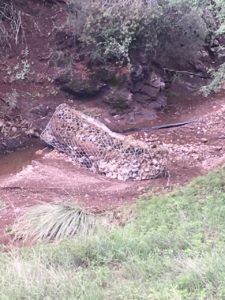 On or about August 9, a short-duration, high-intensity precipitation event on the order of a five- year event (based on National Oceanic and Atmospheric Administration point precipitation frequency estimates, and radar data) passed through the area, resulting in damage to the completed work.
On or about August 9, a short-duration, high-intensity precipitation event on the order of a five- year event (based on National Oceanic and Atmospheric Administration point precipitation frequency estimates, and radar data) passed through the area, resulting in damage to the completed work.
Forest engineering, minerals and geology staff and U.S. Geological Survey scientists inspected and evaluated the damage, and determined a more sustainable and robust system was needed to meet project goals.
Coronado National Forest personnel are assembling a team of U.S. Geological Survey scientists and U.S. Forest Service professionals with expertise in remediation of similar conditions. Once in place, the team will design the improved system and identify a timeline to implement the project.
Further developments will be announced through future news releases.

Aug 15, 2016 | Blog
FOR IMMEDIATE RELEASE
AUGUST 15, 2016

Ocelot, photo US FWS
TUCSON, Ariz. – The U.S. Fish and Wildlife Service released a recovery plan that will guide restoration and protection of the ocelot populations in Arizona and Texas and in bordering Mexican states of Sonora and Tamaulipas. The ultimate goal of the plan is to increase the number of ocelots in both nations, protect their habitat and create connecting habitat corridors between Arizona and Sonora and between Texas and Tamaulipas. This unique endangered cat ranges as far south as Argentina, but in the U.S. is found only in two small areas of Arizona and Texas.
Statement by Rob Peters, senior Southwest representative for Defenders of Wildlife
“It is encouraging to see a plan that sets quantitative targets for ocelot recovery – 1,200 animals in the Texas-Tamaulipas area and 1,000 in the Arizona-Sonora. To reach these targets, wildlife agencies must decrease deaths and increase important thorn scrub habitat, goals that will require funding and binational cooperation. A serious question is whether there is the political will to provide the necessary resources and limit development.
“Big threats to ocelot recovery in the U.S. include giant open-pit mines like the Rosemont and Hermosa proposed in ocelot habitat in Arizona. In south Texas, three huge liquefied natural gas export terminals are planned right next to the Atascosa National Wildlife Refuge. One terminal would sit on – and possibly sever – an ocelot travel corridor identified by the U.S. Fish and Wildlife Service as vital to the recovery of the ocelot population in Texas. This recovery plan is a starting point, but it will only succeed if harmful developments are stopped and sufficient resources are provided for key conservation actions. Defenders will vigilantly monitor proposed development activities that threaten the future of the ocelot in the United States.”
Background:
U.S. ocelot populations, once extending into Arkansas and Louisiana, have shrunk to a small patch of southern Texas, with perhaps 50 animals, and southern Arizona, where only five animals have been detected since 2009. Ocelots, found in every country south of the United States except Chile, are endangered throughout their range. Some 95 percent of the cats’ native habitat in the U.S. has become urbanized or has been converted to agriculture.
Listed under the Endangered Species Act in 1982 as endangered, the species was initially pushed to the brink of extinction due to habitat loss and overhunting. Now, collisions with vehicles and insufficient habitat are keeping ocelot population numbers in the U.S. low. Mines and liquefied natural gas plants are important new threats.

Jul 29, 2016 | Blog
Massive Mine Threatens America’s Only Known Jaguar, Local Water Supplies
 In an important development in the effort to save America’s only known jaguar, the U.S. Army Corps of Engineers’ Los Angeles regional office has recommended denial of an essential permit for the proposed Rosemont copper mine in southern Arizona. The denial recommendation was forwarded this week to the Corps’ San Francisco office, which has said it will issue a final decision within six months. The massive open pit copper mine would destroy thousands of acres of public land in the heart of the home territory of El Jefe, America’s only known wild jaguar, but it cannot proceed without a Clean Water Act permit Rosemont is seeking.
In an important development in the effort to save America’s only known jaguar, the U.S. Army Corps of Engineers’ Los Angeles regional office has recommended denial of an essential permit for the proposed Rosemont copper mine in southern Arizona. The denial recommendation was forwarded this week to the Corps’ San Francisco office, which has said it will issue a final decision within six months. The massive open pit copper mine would destroy thousands of acres of public land in the heart of the home territory of El Jefe, America’s only known wild jaguar, but it cannot proceed without a Clean Water Act permit Rosemont is seeking.
“It’s very encouraging to see the Corps moving toward denial of this permit,” said Randy Serraglio, conservation advocate with the Center for Biological Diversity. “The record is clear — the Rosemont mine would pollute Arizona’s air, drain its water supply and do tremendous damage to its wildlife and wild places that could never be adequately mitigated. The Corps has apparently concluded what we’ve known all along — that the Rosemont mine is simply not in the public interest.”
The Army Corps administers Section 404 of the Clean Water Act under authority delegated by the Environmental Protection Agency, which has repeatedly recommended against issuing the permit. EPA officials have sharply criticized the mining company’s mitigation plan as woefully inadequate and identified a litany of questions and cited problems surrounding the controversial mine. EPA also retains the authority to veto the Clean Water Act permit should it be issued.
“The Corps has studied the Rosemont mine proposal for several years now, but no matter how many ways you look at this boondoggle, it doesn’t add up for Arizonans or the beautiful place they live,” said Serraglio. “In this age of climate change and decades of ongoing drought, the threats to our water, in particular, are too egregious to allow this mine to proceed.”
See rare video footage of El Jefe and learn more about the fight to stop the Rosemont mine.
The Center for Biological Diversity is a national, nonprofit conservation organization with more than 1.1 million members and online activists dedicated to the protection of endangered species and wild places.
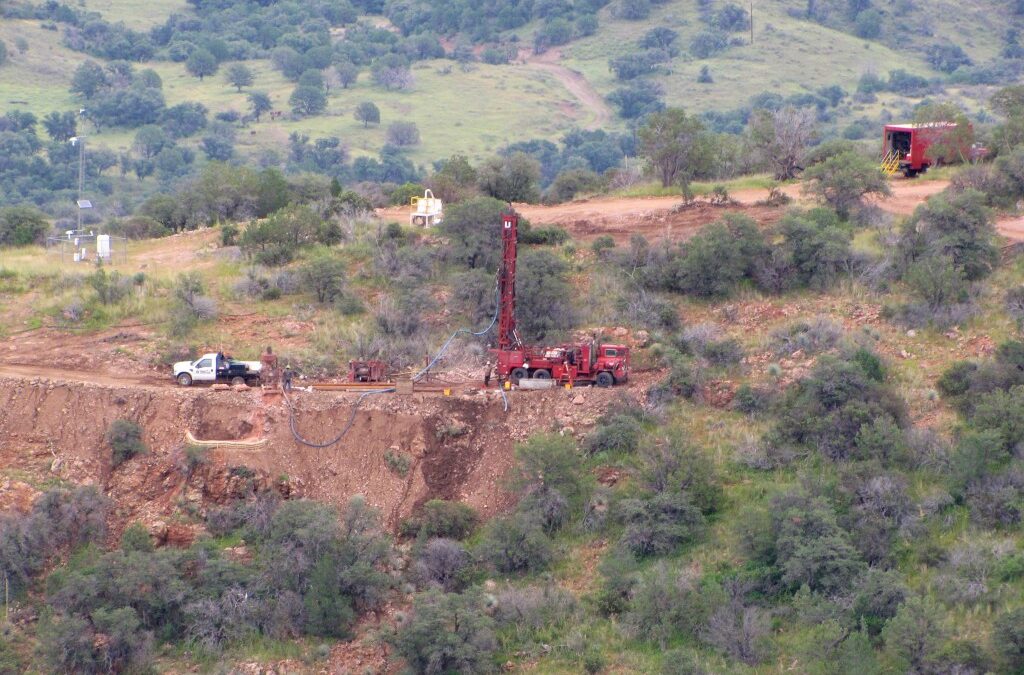
Jun 10, 2016 | Blog
The Price We Pay for the Mining Game, By Michael Stabile
A few years back Arizona Minerals, AKA Wildcat Silver, said they had discovered a great big silver deposit up in the Patagonia Mountains. They were going to recover over a million ounces of silver at a lower cost then any other silver mine in the country. They also had incredible amounts of manganese associated with the silver. They couldn’t say enough about their discovery. They did extensive exploratory drilling on their private landholdings to try and prove its value. They made two attempts to come onto public land for more exploration, but they backed down from both. Then there was silence; no more talk of the open pit silver mine. Was there a problem with the extraction of the silver from the manganese carbonate?
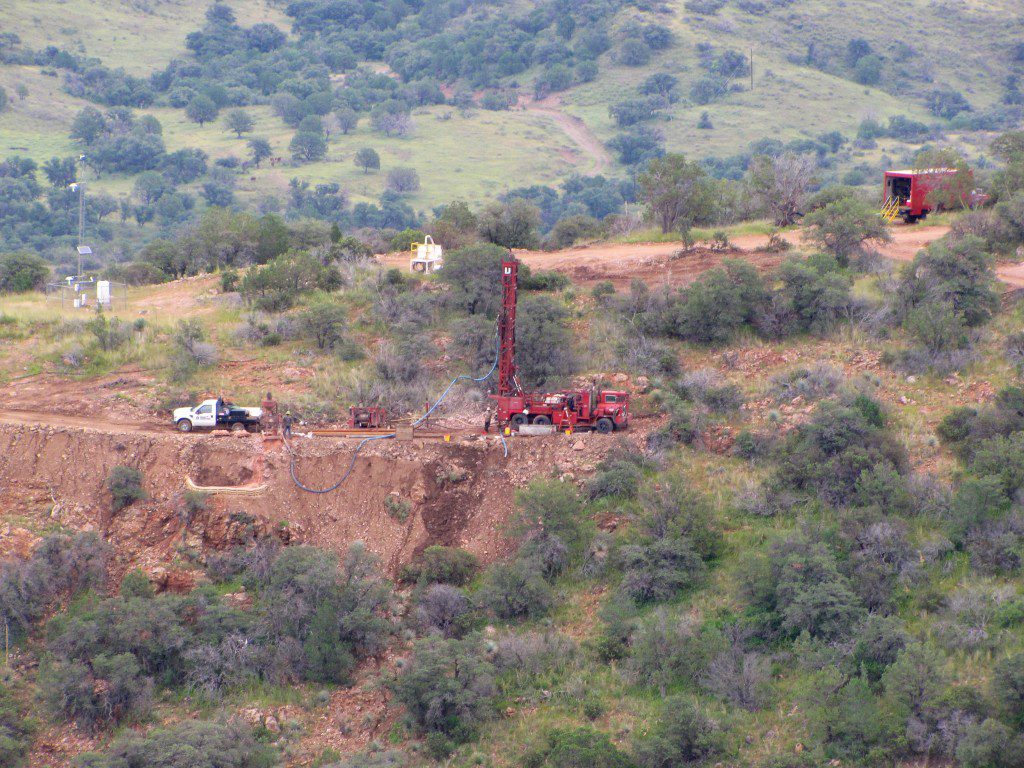
Wildcat Silver / AZ Mining Inc mineral drilling
That process was a difficult one, very dirty and not very productive. The cost of the project was estimated to be about $800,000,000 and water use approximately 1.5 billion gallons yearly. They still talk about the Hermosa project, originally called “Hardshell,” on their website, but have made no more effort to proceed with the mine plan.
Suddenly there was talk from people associated with Arizona Minerals about a new and better discovery: lead and zinc with some silver. This discovery was on land they purchased from the state, called the ASARCO Multi-State Environmental Custodial Trust. ASARCO was a mining company that operated here in Arizona, as well as other states, and went bankrupt and left behind a legacy of Superfund sites. Here in our neck of the woods ASARCO operated the Trench Mine which has been polluting the waters of Alum Gulch and Flux Canyon for years.
Arizona Minerals paid a price of under $100 for 300+ acres for the land — pretty cheap — but for such a low price, they are required to build a passive water control system to contain leaks from the old mine, which would cost upwards of two million dollars. They will also be responsible for any pollution that might escape the area. The new discovery is located on this land, 2,000+ feet below the surface. And in all their investor reports, they are not mentioning the cost of cleaning up the Trench Mine or the incredible costs of extracting minerals at great depth.
I recommend that concerned citizens of Patagonia drive up Harshaw Road and view the destruction that has taken place as Arizona Mining mounts an expedited drilling program to try and prove their discovery. They have closed down the Flux Canyon Road because it is now on their property. Turns out the Forest Service doesn’t have an easement from ASARCO or the state so anyone who wants to enjoy this area – birding, ATVing, hiking, hunting, etc. can no longer access this area.
My biggest concern, and something that should concern every resident of the area about Arizona Minerals, is that they control over 15,000 acres of public lands in the heart of Patagonia’s watershed and some of the most bio-diverse terrain in America. What can we do to protect this area from continued destruction? We the residents, who care about this special place, can make our voices heard. The last thing investors in these mining operations want to hear about is local opposition. This implies that the permitting process will be long, and any return on investment will take years. How do we make our voices heard? Contact state and local officials and state your concern for the watershed, the surrounding habitat where several endangered species live and thrive. Put signs in your yards stating opposition to the mine, We must protect Patagonia, a precious jewel that exists nowhere else in this great country of ours.
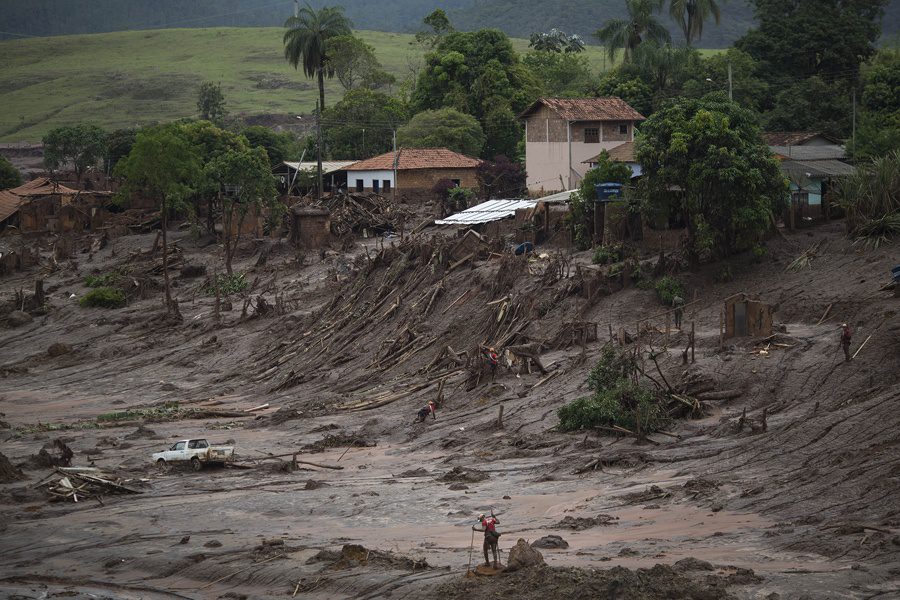
Nov 11, 2015 | Blog
New research validated: mining disasters on the rise because of modern mining techniques
EARTHWORKS News Release
Washington, D.C. — A mine waste dam at the Germano open-pit iron ore mine in Brazil’s state of Minas Gerais breached Thursday, flooding the downstream area with mining waste and causing fatalities. The Germano facility is co-owned by two of the world’s largest mining companies, Brazilian Vale SA and Anglo-Australian BHP Billiton.
A recent report, The Risk, Public Liability & Economics of Tailings Storage Facility Failure, demonstrates that catastrophic mine waste failures are increasing in frequency and severity because of — not in spite of — modern mining techniques, and will continue to do so until regulators and mining companies take active steps to prevent them.

Rescue workers walk at the site where the town of Bento Rodrigues stood after two dams burst on Thursday, in Minas Gerais state, Brazil, Sunday, Nov. 8, 2015. Brazilian rescuers are looking for people still listed as missing following the burst of two dams at an iron ore mine which sent viscous red mud, water and debris flooding into the town, flattening all but a handful of buildings and killing dozens. (AP Photo/Felipe Dana)
“Our research shows that more mining waste disasters like Brazil’s Germano spill are inevitable,” said David Chambers, report co-author and director of the Center of Science in Public Participation. He continued, “If mining practices continue as usual, we are going to see more severe spills, more frequently. These spills each will cost the public hundreds of millions to billions of dollars to clean up – if cleanup is possible at all. And sometimes, like the Germano spill, they will cost people’s lives.”
Chambers’ report, co-authored with Lindsay Newland Bowker, was researched in response to the 2014 Mount Polley mine waste disaster in British Columbia, another waste impoundment failure which released roughly 24.4 million cubic meters of mine tailings waste into the Fraser River watershed. An expert panel commissioned by the BC provincial government recommended the global mining industry make significant changes to how it handles mining waste. To date those recommendations have been largely ignored.
“The Mount Polley disaster should have been a wake-up call to the mining industry,” said Earthworks’ mining director Payal Sampat. She continued, “But mining companies and government regulators failed to act – and tragically, now mining spills are killing people as well as wildlife. We cannot afford to wait for the next mining disaster before we protect communities and the environment from risky mining practices.”
There are 839 mining waste tailings dams in the United States and approximately 3,500 around the world, according the U.S Army Corps of Engineers and the United Nations, respectively. Large dams built to contain mining waste, among the largest structures in the world, must stand in perpetuity. Yet there is no federal agency in the U.S., nor global entity, responsible for oversight of mining waste tailings dam safety. 38 civil society organizations around the world urged the United Nations Environment Programme (UNEP) to push companies and national governments to address the threats mine waste dams pose. UNEP Director Achim Steiner responded with plans to review current guidance and work with stakeholders to examine next steps. Efforts are also underway to pressure US and Canadian governments to take stock of mining waste tailings dams.
Primary findings of The Risk, Public Liability & Economics of Tailings Storage Facility Failure include:
- The rate of serious tailings dam failures is increasing. Half (33 of 67) of serious tailings dam failures in the last 70 years occurred in the 20 years between 1990 and 2009.
- The increasing rate of tailings dam failures is propelled by, not in spite of, modern mining practices. The increasing rate of tailings dam failures is directly related to the the increasing number of TSFs larger than 5 million cubic meter capacity necessitated to allow the economic extraction of lower grades of ore.
- 11 catastrophic failures are predicted globally from 2010 to 2019. Predicted total cost of these 11 failures is approximately $6 billion.
- The average cost of the these catastrophic tailings dam failures is $543 million. Regulator attempts to recoup cleanup costs from mining operators reveal — through court records and other official documents — dollar totals for cleanup and recovery.
- Mining companies cannot afford, and cannot secure insurance to cover, the costs of catastrophic failures: Losses, both economic and ecological, are in large part either permanent and non-recoverable, or recovery — to the extent physically possible — is funded by public monies.

Oct 26, 2015 | Blog
Environmental Cleanup Actions
The United States Department of Agriculture Forest Service begins this month an environmental cleanup of the Lead Queen Abandoned Mine (Site) situated within the Harshaw Creek watershed. The Site is located approximately six miles south of Patagonia, Arizona, within the Sierra Vista Ranger District of the Coronado National Forest and is only accessed by 4×4 or high clearance vehicles.
The objective of this cleanup is to reduce or eliminate the downstream movement of waste rock containing elevated concentrations of arsenic, lead, and other heavy metals, as well as acid mine drainage to Harshaw Creek.
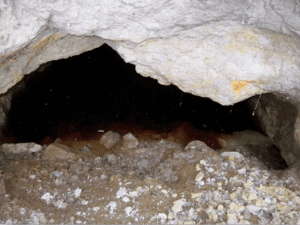
Lead Queen Adit
Past mining activities left behind abandoned horizontal openings (adits) and vertical openings (shafts), and littered the landscape with waste rock material.
The Forest Service hired an environmental firm to perform the cleanup and work should be completed by mid-February 2016. Environmental Cost Management, Inc (ECM) from California was hired for the amount of $361,689.58 of taxpayers’ money to clean up the abandoned mine site on public land.
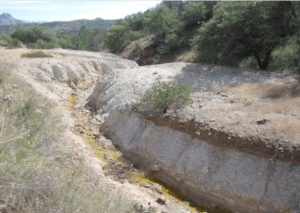
Lead Queen waste rock
The cleanup involves construction activities using heavy equipment to consolidate waste rock into a single underground contained area, cap the waste rock with native soil, and seal 4 of 6 mine openings such as adits and shafts. Polyurethane Foam (PUF) will be used to seal two adits and two shafts. The final PUF face will be covered with clean local soil and rock to prevent UV light degradation of the foam. The other two mine openings will be closed using bat-friendly gates.
In some areas of the Site, adits and shafts serve as conduits carrying large amounts of tunnel water which potentially cause floods in the downstream channels. Storm runoff carries concentrations of heavy metals stored in these adits and shafts on the surface.
Scope of Work
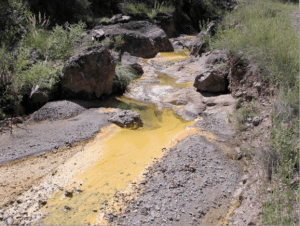
Lead Queen toxic, heavy metal drainage
The Site Cleanup will consist of excavating waste rock, hauling and placing waste rock material in a consolidation area, constructing a series of gabion walls, improving existing road for equipment access, constructing temporary access roads to mines, closing mine features, installing bat- friendly gates, and seeding and mulching of all disturbed areas.
A series of gabion walls will mitigate the transport of aluminum precipitate and red-orange sludge and sediment downstream of the Site and into the lower reaches of the Harshaw Creek watershed. These gabion walls will be installed in the drainage bottom at various locations downstream of the Site.
CERCLA Time Critical Action Removal Action
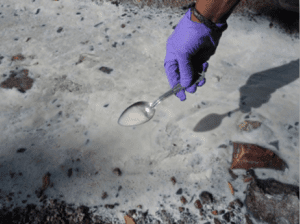
Sampling at Lead Queen mine site
The Forest Service is exercising its authority under the Comprehensive Environmental Response, Compensation, and Liability Act (CERCLA; 42 U.S.C. 9601 et seq.) to conduct the cleanup activities at the Site. The Time Critical Removal Action Approval Memorandum documents and explains the commencement of a CERCLA Removal Action at the Site. The Forest Service’s role is to protect the public health and welfare and the environment and to respond to a hazardous substance release on lands under the jurisdiction of the Forest Service, pursuant to the authority found in 42 U.S.C. 9604(a), Executive Order 12580, and 7 C.F.R. 2.60(a)(39).
Public Information
For additional information about the cleanup, please contact:
Eli Curiel Jr., P.E.,
Project On-Scene Coordinator
USDA Forest Service
Coronado National Forest
300 West Congress Street Tucson, AZ 85701
(520) 388-8413
Monday-Friday, 9:00 AM – 4:30 PM

Related links:
Forest Service Outlines Clean Up Plans for Abandoned Lead Queen Mine https://www.patagoniaalliance.org/forest-service-outlines-clean-up-plans-for-abandoned-lead-queen-mine/
Video: Leaking Historic Patagonia, Arizona Mines https://youtu.be/uEgaFhT5RXw
The U.S. Department of Agriculture (USDA) prohibits discrimination in all its programs and activities on the basis of race, color, national origin, age, disability, and where applicable, sex, marital status, familial status, parental status, religion, sexual orientation, genetic information, political beliefs, reprisal, or because all or part of an individual’s income is derived from any public assistance program. (Not all prohibited bases apply to all programs.) Persons with disabilities who require alternative means for communication of program information (Braille, large print, audiotape, etc.) should contact USDA’s TARGET Center at (202) 720-2600 (voice and TTY). To file a complaint of discrimination, write to USDA, Director, Office of Civil Rights, 1400 Independence Avenue, SW, Washington, DC 20250-9410 or call (800) 795-3272 (voice) or (202) 720-6382 (TTY). USDA is an equal opportunity provider and employer.

Sep 16, 2015 | Blog
FOR IMMEDIATE RELEASE
Contact: Courtney Sexton, csexton@defenders.org, 202-772-0253
Wendy Russell, wendy@patagoniaalliance.org, 520-477-2308
Federal court flips the off switch on Forest Service’s approval of “Sunnyside” project in Coronado National Forest
Tucson, Ariz. —A district court in Arizona put the brakes on an environmentally destructive exploratory drilling project in the Coronado National Forest near Patagonia, Arizona, saying the Forest Service failed to conduct the appropriate environmental review before fast-tracking the approval of the “Sunnyside” project. In October 2014 conservation groups Defenders of Wildlife and the Patagonia Area Resource Alliance (PARA) filed a lawsuit claiming the Forest Service’s approval violated environmental laws and posed a threat to endangered species in the area.
Statement from Rob Peters, Defenders of Wildlife:

Pictured: Ocelot by Steve Harris
“This is a great victory for the many species of imperiled wildlife that call the Coronado National Forest and the Mountain Empire region home, especially the jaguar, Mexican spotted owl, ocelot and yellow-billed cuckoo, all of which are already at risk from multiple projects in the region.
“The court’s ruling against this destructive mining operation is the best thing that could have happened for the residents of Patagonia and for the incredible and diverse wildlife in the area.”
Statement from Wendy Russell, Patagonia Area Resource Alliance:
“We’re not going to stand by and let the Forest Service rubber-stamp these mining projects in the Patagonia Mountains. There’s too much at stake for both our community and wildlife. This is the second time we’ve had to take them to court, and the second time we’ve won.”
Defenders and PARA were assisted in the case by Roger Flynn, an attorney with the Western Mining Action Project. Flynn noted the importance of local residents’ right to participate in the Forest Service’s review of mineral projects on public land – residents were excluded from this process in the fast-tracking of the approval, a violation of federal law.
Background:
The Canadian mining company Regal Resources’ Sunnyside Project (an exploratory mining operation) involves drilling six exploratory holes for copper deposits up to 6,500 feet deep roughly five miles from the town of Patagonia, Arizona. The Forest Service issued a “categorical exclusion” decision which essentially fast-tracked the mineral drilling exploration and approved the project without involving the public or taking a hard look at the project’s impacts to endangered species. The decision authorized Regal Resources to run its drill rigs for at least five months in sensitive endangered species’ habitat. Loud mineral drilling operations and construction would occur 24 hours a day, seven days a week (using artificial lighting at night) with total project operations and reclamation lasting up to three years.
In January of this year, the Forest Service temporarily withdrew approval for the Sunnyside project until it completed consultation with the U.S. Fish and Wildlife Service to determine whether the project would significantly affect the western yellow-billed cuckoo, which is listed as a federally threatened species. After completing the consultation and concluding that there would be no significant effects, the Forest Service re-issued its approval for drilling to proceed in April, 2015.
###
Defenders of Wildlife is dedicated to the protection of all native animals and plants in their natural communities. With more than 1.2 million members and activists, Defenders of Wildlife is a leading advocate for innovative solutions to safeguard our wildlife heritage for generations to come. For more information, visit www.defenders.org and follow us on Twitter @DefendersNews.
The Patagonia Area Resource Alliance is a citizen watchdog organization that monitors the activities of mining companies, as well as ensures government agencies’ due diligence, to make sure their actions have long-term, sustainable benefits to our public lands, our water, and the town of Patagonia. For more information visit www.patagoniaalliance.org and follow us on Twitter @PARAalliance.
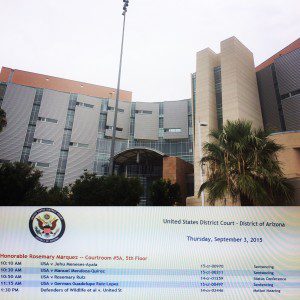
Sep 9, 2015 | Blog
 The Patagonia Area Resource Alliance and Defenders of Wildlife were in federal court in Tucson last Thursday to present oral arguments against the Forest Service’s unlawful approval of a mining exploration project in the Patagonia Mountains on the Coronado National Forest.
The Patagonia Area Resource Alliance and Defenders of Wildlife were in federal court in Tucson last Thursday to present oral arguments against the Forest Service’s unlawful approval of a mining exploration project in the Patagonia Mountains on the Coronado National Forest.
Over 20 people attended the court hearing in support of PARA, Defenders of Wildlife and the Patagonia Mountains.
Canadian mining company Regal Resources’ Sunnyside Project involves drilling six exploratory holes for copper deposits up to 6,500 feet deep roughly five miles from the Town of Patagonia.
The Forest Service issued a “categorical exclusion” decision which essentially fast-tracked the mineral drilling exploration and approved the project without doing any environmental assessments. The decision authorized Regal Resources to run drilling for one year, with a seven month stoppage during the breeding seasons of the Mexican spotted owl and Yellow-billed cuckoo.
Defenders of Wildlife Lawyer Jay Tutchton argued that the Forest Service’s approval of the Sunnyside project violates environmental laws and poses a potential threat to local, endangered species. The extensive mineral drilling and construction would run 24 hours a day, seven days a week with total project operations and reclamation lasting up to 3 years.

Mexican Spotted Owl ©Gooch Goodwin
The Patagonia Mountains support some of the world’s most threatened and endangered wildlife, including the jaguar, ocelot, lesser long-nosed bat, Mexican spotted owl, and yellow-billed cuckoo. Of particular concern is the Mexican spotted owl “Protected Activity Center” (PAC), prime habitat which is supposed to have the greatest protection by law and is occupied by the owls year-round. One of the project’s proposed drilling sites is less than 200 yards from a “nesting core area” of the PAC. The noise caused by the drills would be louder than a chainsaw and would disrupt about one-third of the Mexican spotted owls’ PAC, as well as the migratory corridors of jaguars and ocelots, Tutchton argued.
The Forest Service asked the court to dismiss the complaint. Forest Service lawyer Julia Thrower claimed the decision to grant a categorical exclusion complied with the National Environmental Protection Act and was not arbitrary or capricious.
“We’re optimistic that the judge will agree that the Forest Service’s attempt to avoid extra paperwork by skipping environmental assessments violates the law and places local, imperiled wildlife in even more jeopardy,” said Wendy Russell of the Patagonia Area Resource Alliance.
U.S. District Court Judge Rosemary Marquez said that she would take the matter under advisement and would issue her ruling before the proposed October 1 start date.

Jul 31, 2015 | Blog
AZ Mining Inc / Wildcat Silver to Purchase Historic Trench Mine
|
|
|
| Wildcat Silver, now known as AZ Mining Inc, recently announced plans to purchase the 300 acre historic Trench Camp Mine from Asarco Multi-State Environmental Custodial Trust. The custodial trust was formed as a result of a bankruptcy settlement with ASARCO and tasked with cleanup of the abandoned mine.
Mining stopped at the underground Trench mine over 50 years ago, which is located in the Patagonia Mountains adjacent to AZ Mining’s existing 154 acres of private land inholdings. The purchase “will greatly enhance AZ Mining’s surface lands for any future mining operations,” according to a press release.
The press release also stated that AZ Mining Inc “has submitted a remediation work plan that addresses the environmental liabilities with the Arizona Department of Environmental Quality [ADEQ] and will construct a passive water treatment system estimated to cost US$2.6 million, excluding contingency, of which the Company’s share will be US$1.6 million.”
This would be the third time in recent history that the Trench Mine has undergone remediation work. The mine was “largely remediated by ASARCO” in the 1980’s and 1990’s, according to an ADEQ report.
More recent work was necessary after the Trench tailings pile dam overflowed with acidic water loaded with toxic heavy metals when heavy rains hit the Patagonia Mountains in September 2014. ADEQ issued six violations of state water-quality rules as a result of that spill.
AZ Mining Inc takes on these environmental issues with the purchase of the Trench mine. Wendy Russell, PARA Coordinator, told the Weekly Bulletin that she is doubtful the situation will be improved. “I’m really concerned about the environmental issues that we have with the Trench Mine, and if they’ll actually clean it up,” she said.

Highly toxic, acidic orange water overflowing from Trench Mine tailings in September 2014. |
| We have reasons to further question their incentives for this pending purchase. A look at the history of AZ Mining’s CEO and Board Chairman, Richard Warke, reveals questionable business practices as outlined in the documentary, Cyanide Beach, by investigative journalist John Dougherty.
Between 2003 and 2007, Warke was on the Board of Directors of Sargold Resource Corporation. Sargold owned and operated an open-pit gold mine near the small farming village of Furtei in south-central Sardinia, Italy. Cyanide Beach reveals a troubling history of Sargold’s business practices that includes:
- Failure to provide accurate and timely information to shareholders.
- Failure to pay vendors.
- Misspending a Sardinian government loan.
- Evidence of a self-enrichment scheme to benefit its chairman.
- Evidence of insiders receiving excessive discounts on stock purchases.
- Issuing misleading press releases.
Sargold also made numerous promises of clean up of the mine site. They even tried to leverage clean up plans for the acquisition of additional mining rights elsewhere. The clean up was never completed and the only mining that happened was re-mining the old tailings piles at the gold mine.
One day, workers discovered that the mining company had just walked away from the mine, leaving behind an unfolding environmental disaster.
Extensive supporting documentation for Cyanide Beach, including a timeline of the business history of Richard Warke, supported by thousands of pages of corporate disclosures, is posted at investigative journalist John Dougherty’s website: InvestigativeMedia.com.
This disastrous pattern of irresponsible behavior and the pending purchase of the Trench mine in the Patagonia Mountains further compels us in our on-going mission to keep our citizen watchdog eyes wide open and to pro-actively engage in protecting our water, area wildlife, and the well-being of the Patagonia area community. |
|
Thank You PARA Supporters!
We are very fortunate to have a group of amazingly committed community members and generous donors supporting our work. PARA’s efforts to protect and preserve the Patagonia Mountains and our community’s drinking water are only possible because of your financial support.
Consider making an automatic, monthly donation to the Patagonia Area Resource Alliance on your credit card through PayPal.
Every single contribution makes a sizable difference to our organization and ultimately for our community. It is only because of the generous support from people like you that we can undertake this critical work. Thank you! |
|
|
|
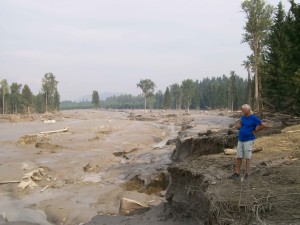
Jul 20, 2015 | Blog
Canadian Mines Ministers Conference in Halifax:
Provinces & Territories Must Act To Avoid Mine Waste Disasters
While Energy & Mines Ministers from across Canada are meeting in Halifax for their annual conference, a coalition of more than 50 environmental, First Nations, and community organizations today sent a letter to all Canadian Mines Ministers urging them to take immediate action to assess and prevent the threat posed by hundreds of mine waste dams and impoundments in Canada.
The groups are pressuring provincial and territorial governments in Canada to respond to the lessons learned from the August 2014 Mount Polley mine disaster in British-Columbia – the biggest mining waste spill in Canadian history.
In January 2015, the Independent Expert Review Panel on the Mount Polley failure determined that current Canadian and global standards for mine waste disposal are fundamentally flawed and that future failures at other mines are simply a matter of time.
The Expert Panel firmly rejected any notion “that business as usual can continue,” and urged the industry and all regulators to change the way mining waste facilities are designed, operated, and regulated in order to avoid any future failures: “The Panel does not accept the concept of a tolerable failure rate for tailings dams. To do so, no matter how small, would institutionalize failure. First Nations will not accept this, the public will not permit it, government will not allow it, and the mining industry will not survive it.”
In the wake of the Mount Polley disaster, the British Columbia government called for an investigation of the safety of all 123 tailings dams within the province, and recently appointed a Mining Code Review Committee to determine how best to implement the panel’s recommendations. No other governments in Canada have yet announced similar measures.

Hazeltine Creek following the spill (photo by Chris Blake).
The groups signing the letter released today urge all Canadian Mines Ministers to work together to support and implement all of the Mount Polley Independent Expert Review Panel’s recommendations in order to avoid any future massive mine waste spill in Canada (see all recommendations in letter). The groups also recommend additional scrutiny for mines upstream of the Canada-U.S. border that could present a risk to either country’s waters.
For further information and a complete list of the signatories, see letter: http://www.patagoniaalliance.org/wp-content/uploads/2015/07/2015-07-20_Mines_Ministers_Letter.pdf
SIGNATORIES TO DATE:
ACTION BORÉALE – ALASKA TROLLERS ASSOCIATION – AMNESTY INTERNATIONAL CANADA – BC FIRST NATIONS ENERGY & MINING COUNCIL – BRITISH-COLUMBIA ENVIRONMENTAL NETWORK – CANADIAN ASSOCIATION OF PHYSICIANS FOR THE ENVIRONMENT – CANADIAN COALITION FOR NUCLEAR RESPONSIBILITY – CANADIAN PARKS & WILDERNESS SOCIETY – CENTER FOR ALTERNATIVE MINING DEVELOPMENT POLICY – CLAYOQUOT ACTION – COALITION FOR A CLEAN GREEN SASKATCHEWAN – COALITION POUR QUE LE QUÉBEC AIT MEILLEURE MINE – COMITÉ MINE DE RIEN DE ST-CAMILLE – COMITÉ POUR LES DROITS HUMAINS EN AMÉRIQUE LATINE – COMITÉ VIGILANCE DE MALARTIC – COMMITTEE FOR FUTURE GENERATIONS – COUNCIL FOR PUBLIC HEALTH IN MINING COMMUNITIES – COUNCIL OF CANADIANS – QUILL PLAINS CHAPTER – DAVID SUZUKI FOUNDATION – EARTHWORKS – ECOSYSTEM DEFENSE DIRECTOR – FAIR MINING COLLABORATIVE – FONDATION RIVIÈRES – FOREST PROTECTION ALLIES – FRASER RIVERKEEPER – FRIENDS OF THE CLEARWATER – FRIENDS OF THE EARTH CANADA – GRAND RIVERKEEPER LABRADOR – GROUPE DE THÉOLOGIE CONTEXTUELLE QUÉBÉCOISE – GROUPE SOLIDARITÉ JUSTICE – INTER-CHURCH URANIUM COMMITTEE EDUCATIONAL CO-OPERATIVE – JUST ONE WORLD – KAIROS – KIPAWA LAKE PRESERVATION SOCIETY – MARITIMES-GUATEMALA BREAKING THE SILENCE SOLIDARITY NETWORK – MINING INJUSTICE SOLIDARITY NETWORK – MININGWATCH CANADA – NORTHERN CONFLUENCE – NORTHWATCH – NUCLEAR INFORMATION AND RESOURCE SERVICE – OKANOGAN HIGHLANDS ALLIANCE – ONTARIANS FOR A JUST AND ACCOUNTABLE MINERAL STRATEGY – PATAGONIA AREA RESOURCE ALLIANCE – PEACE-NB – POLARIS INSTITUE – PRIMATE’S WORLD RELEASE AND DEVELOPMENT FUND – QUESNEL RIVER WATERSHED ALLIANCE – RAPIDE-BLANC PRODUCTIONS – REGROUPEMENT JUSTICE/ENVIRONNEMENT DES SŒURS DE SAINTE-CROIX – REGROUPEMENT POUR LA SAUVEGARDE DE LA GRANDE BAIE DE SEPT-ÎLES – RENEWABLE POWER INTELLIGENT CHOICE – RÉSEAU ŒCUMÉNIQUE JUSTICE ET PAIX – RIVERS WITHOUT BORDERS – ROCK CREEK ALLIANCE – SAVE OUR SKY BLUE WATERS – SCIENCE FOR PEACE – SEPT-ILES SANS URANIUM – SIERRA CLUB – SOCIÉTÉ POUR VAINCRE LA POLLUTION – SOUTHEAST ALASKA CONSERVATION COUNCIL – SQUAMISH ENVIRONMENT SOCIETY – UNION OF BC INDIAN CHIEFS – WATERSHED WATCH SALMON SOCIETY – WEBER SUSTAINABILITY CONSULTING.
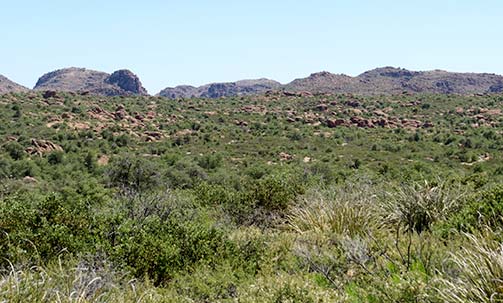
Jun 24, 2015 | Blog

photo by Hunter Kerhart
The National Trust for Historic Preservation has named Oak Flat, near Superior, Arizona, to its 2015 list of America’s 11 Most Endangered Historic Places. The annual list spotlights important examples of the nation’s architectural, cultural and natural heritage that are at risk of destruction or irreparable damage.
Oak Flat is sacred to the San Carlos Apache and other Native American tribes and is currently protected from mining by orders issued by Presidents Eisenhower and Nixon. Oak Flat contains many cultural resources including archaeological and historical sites, as well as being eligible for inclusion on the National Register of Historic Places as a Traditional Cultural Property. Oak Flat continues to be used and relied upon today for the religious, traditional, and cultural practices of Apaches and other Native peoples. The Apache people know Oak Flat as Chi’chil Bildagoteel.
Oak Flat is currently threatened by a massive proposed copper mine. A land exchange included in the National Defense Authorization Act of 2015 would open the site up to mining. The Arizona Mining Reform Coalition and partners, including the San Carlos Apache, encourage members of Congress to reconsider this land exchange, as any mining activity at Oak Flat would severely threaten this sacred place.
“We hope this designation increases national awareness of Oak Flat and its profound importance to Native American tribes,” said Stephanie Meeks, president of the National Trust for Historic Preservation. “The tribes who regard Oak Flat as a sacred place were not adequately consulted before this land exchange took place. Before any potentially harmful mining activity takes place at Oak Flat, we need to make sure the tribes and others who care about this important place have a voice in shaping its future.”
“The Arizona Mining Reform Coalition and its member groups deeply appreciate this designation by the National Trust for Historic Preservation,” said Roger Featherstone, Director of the Arizona Mining Reform Coalition. “We have prayed, played, and enjoyed Oak Flat for years and to lose this national public treasure to foreign mining companies would truly be a tragedy. What the U.S. congress did in the dead of night last December to give Oak Flat away is not how we should treat our sacred places. We encourage members of Congress to reconsider the land swap embedded deep within the National Defense Authorization Act of 2014.”
Arizona Representative, Raúl Grijalva, along with 14 bi-partisan co-sponsors, has introduced H.R. 2811, the Save Oak Flat Act, to repeal Section 3003 of the National Defense Authorization Act. Section 3003 authorizes the give-away of Oak Flat to foreign mining companies as soon as environmental studies are completed and published, regardless of their conclusions.
The National Park Service is currently accepting public comments (deadline is June 29) for the nomination of Chi’chil Bildagoteel to the National Register of Historic Places as a Traditional Cultural Property.
A continuous encampment at Oak Flat has been in place to protect its sacredness since February 7, 2015. The encampment is being led by Apache Stronghold, and includes people from all walks of life including Tribal members from across the country.
At a time when some western state legislatures seek to transfer federal public lands to state control, this is an example of how resources owned by the American people may be sold or traded away to foreign-owned companies for development. This threat adds to those faced by other National Treasures like the Grand Canyon, Mount Taylor, and other efforts to mine or develop sacred lands of Native People.
The Arizona Mining Reform Coalition works to protect Arizona’s communities and the environment from inappropriate mining activities. The Patagonia Area Resource Alliance is a Coalition Member. www.azminingreform.org
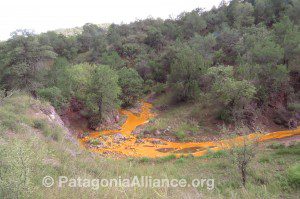
May 8, 2015 | Blog

Toxic overflow from the historic Lead Queen mine in the Patagonia Mountains drains towards Harshaw Creek.
The Coronado National Forest, Sierra Vista Ranger District hosted a community meeting in Patagonia, Arizona on April 28. The Lead Queen Mine cleanup plan was by presented by Floyd Gray of United States Geological Survey (USGS), and Eli Curiel of the Forest Service.
The Lead Queen was an underground mine for lead, silver, zinc, copper and gold that started in 1898 and was abandoned after 1940. After heavy rains in September 2014, members of PARA discovered and reported the leaking mine site, located approximately 6 miles south of Patagonia, Arizona. In December, the Arizona Department of Environmental Quality served the Forest Service with two notices of violation for the toxic mine spill. The Forest Service issued a “Time Critical Removal Action Approval Memorandum” in February to mitigate the spill and its potential threats to public health and welfare, water and wildlife. Clean up was scheduled to start Spring 2015, before monsoon rains could potentially wash contamination further downstream.
Floyd Gray gave an overview of his findings from sampling and testing the water, soil, and waste rock around the abandoned mine site. It was also deduced that there is more than one source of leakage from the mine site. One source was identified by its extreme concentration of iron while the other source is high in aluminum. All of the tested samples came back with very high levels of contamination from hazardous heavy metals such as arsenic and lead. In one water sample, the heavy metal levels were 20 times higher than the allowable drinking water standards. It was also determined that the mine contamination traveled 9/10th of a mile downstream.
The studies at the Lead Queen site to determine all of the sources of contamination has lead to a larger, ongoing study of the watersheds in the Patagonia Mountains by USGS and the Forest Service.
Eli Curiel detailed the plans to plug the six abandoned tunnels and shafts of the Lead Queen mine site with polyurethane foam. The waste rock piles laced with toxic heavy metals will be consolidated into a new location above the watershed and capped with clean fill to prevent future contamination. The polluted sediment in the waterway will be removed with the aid of a series of eleven gabion walls across the drainage filled with zeolite to capture and hold the heavy metals. The clean up area comprises five acres on the Coronado National Forest in the Patagonia Mountains. The mine site will require ongoing monitoring and maintenance, essentially forever.
The cost to taxpayers has not yet been determined. The clean up project has not yet gone out to bid. It’s expected to take up to 120 days with work possibly starting this summer.
More information can be obtained from the Forest Service Project On-Scene Coordinator, Eli Curiel at 520-388-8413.
Regal Resources Sunnyside Mine Exploration

Mexican Spotted Owl ©Gooch Goodwin
At the public meeting, an update was given on Regal Resources’ Sunnyside mining exploration project in the Patagonia Mountains by Forest Service Geologist Mindy Vogel. Conspicuously absent from Vogel’s overview was the ongoing litigation between Defenders of Wildlife and PARA against the Forest Service and US Fish and Wildlife for the unlawful approval of this project.
For the present time, no work is allowed at the Sunnyside site between March 1 and Oct 1, 2015 because of nesting Mexican spotted owls and Yellow-billed cuckoos in the area, according to the Forest Service Decision Memo.
No questions were permitted during any of the presentations. Audience members were required to seek out Forest Service and USGS personnel after all presentations were complete to ask questions. It is a format that we find effectively prevents members of the community from getting all of their questions answered and learning the most information possible.
Wildcat Silver Hermosa Proposal
Forest Service geologist Margie DeRose gave an overview and an update of the expected timeline of the AZ Mining Inc (aka Wildcat Silver, AMI) Hermosa mining exploration proposal in the Patagonia Mountains on the Coronado National Forest. The final Environmental Assessment and draft decision is estimated for release in October 2015 – over a year past the original timeline. A 45 day public objection period will follow.
Meanwhile, AZ Mining Inc / Wildcat Silver board chairman Richard Warke is privately funding more mine exploration drilling on their privately owned land. AZ Mining Inc / Wildcat Silver is now claiming that deposits for lead, zinc and silver exist for an additional mine at the Hermosa project, referred to as Hermosa North West.

Apr 27, 2015 | Blog
New Decision Memorandum Issued for Sunnyside Mineral Drilling Project in Patagonia Mountains
 The Forest Service sent out a notice on April 10th that a new Decision Memo has been issued for the Regal Resources Sunnyside project, an exploratory mineral drilling proposal in the Humboldt Canyon and Alum Gulch areas of the Patagonia Mountains on the Coronado National Forest.
The Forest Service sent out a notice on April 10th that a new Decision Memo has been issued for the Regal Resources Sunnyside project, an exploratory mineral drilling proposal in the Humboldt Canyon and Alum Gulch areas of the Patagonia Mountains on the Coronado National Forest.
The emailed notice from the Forest Service stated that exploratory drilling can start once “the operator provides a reclamation performance bond, incorporates the design features from the decision document, and the Plan of Operations is approved.”
The notice is misleading because it fails to mention two important facts.
No drilling can take place between March 1 to September 30 to avoid potential disturbance to the Mexican spotted owl and Yellow-billed cuckoo during their breeding season, as stated in the Decision Memo.
Additionally, PARA and Defenders of Wildlife are still in litigation against the Forest Service and US Fish and Wildlife Service for this unlawful approval of the Sunnyside Proposal. Read more…
The Sunnyside mineral drilling proposal is located approximately 7 miles south of the town of Patagonia. For more information concerning this decision, please contact Mindy Sue Vogel, Geologist, Coronado National Forest, 300 W. Congress Street, Tucson, AZ 85701, 520-388-8327, msvogel@fs.fed.us.
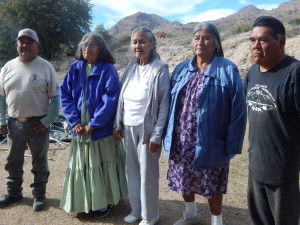
Apr 16, 2015 | Blog
FOR IMMEDIATE RELEASE
San Carlos, AZ – Tribal elders of the San Carlos Apache Tribe are geared up to join the Protect Oak Flat Street Fair that is slated for Sunday, April 19th in Tucson, in conjunction with Cyclovia Tucson, a car-free community celebration.

Apache Elders at Oak Flat
“We are Apaches and we never give up,” pointed out Anthony Logan, Holy Ground Medicine Man, in his native San Carlos Apache language. We are here in prayer and still occupying our sacred ancestral land. Creator God gave us this land to take care of and to continue our Holy Ground ceremonies.”
“We have a responsibility to take care of our sacred sites and we will be blessed for our sacrifices made on behalf of our Mother Earth. We are still here at Chi’Chil’Bilda’Goteel,” concluded Medicine Man Logan.
Apache Stronghold has maintained a continuous “occupation” of the proposed mine site since February 7th, 2015.
“We continue to stand up and advocate for our Apache way of life, what we believe and what we have been taught by our ancestors,” says Audrey Johnson, tribal elder, in her native San Carlos Apache language. “Oak Flat is known to us as Chi’Chil’Bilda’Goteel and our Apache people and other Indigenous Peoples from all over have been occupying our ancestral land there. We are still opposing the Southeast Arizona Land Exchange where Resolution Copper Company under Rio Tinto/BHP is proposing to build a $64.1 billion dollar mine at Oak Flat. One of the key players in this “land grab” is Arizona Senator John McCain. He appears to have no disregard to our Apache People and our way of life. Shame on him.”
“Our waters will be contaminated and our ancestral land will forever be destroyed and our ceremonial and holy sites and even burial sites and we want the world to know that we oppose such desecration by a foreign company,” concluded tribal elder, Audrey Johnson.
What: Protect Oak Flat Street Party
Where: 238 E. 26th street
When: Sunday, April 19th, 10am-3pm
Everyone is invited to join in the cause from 10:00 a.m. to 3:00 p.m. and for more information, contact Wendsler Nosie, Sr., at (928) 200-5045 or Sandra Rambler at (928) 951-6939. Or visit www.Apache-Stronghold.com

Apr 13, 2015 | Blog
FOR IMMEDIATE RELEASE
Kevin Pakulis Band to play benefit concert for Friends of the Mountain Empire, with special guest appearance from Congressman Raúl Grijalva
TUCSON, ARIZ. — The Kevin Pakulis Band will play a benefit concert to raise funds and awareness for the Friends of the Mountain Empire on Saturday, May 9th at the Hotel Congress in Tucson. Tickets for the magical evening of music can be purchased now to support the organizations – Patagonia Area Resource Alliance, Sky Island Alliance, Defenders of Wildlife, Tucson Audubon Society, Center for Biological Diversity and Save the Scenic Santa Ritas – that are working to protect and preserve the habitat, water, and wildlife of the Mountain Empire from new mining in the Patagonia Mountains, Santa Rita Mountains, Canelo Hills, and the San Rafael Valley of southern Arizona.

The event will provide a unique and exciting opportunity to hear the soulful music of Tucson-based, award-winning Americana singer-songwriter Kevin Pakulis, while supporting the incredible ecological and cultural biodiversity of the region.
“Our goal is to draw attention to the local organizations that play a vital role in protecting and restoring wild places in southern Arizona. More specifically, to draw attention to the message they bring – a message that deserves careful consideration, if not enthusiastic action,” said Pakulis.

Ocelot, photo US FWS
Arizona’s southwestern Mountain Empire is a hidden gem of the country, recognized for its beauty, uniqueness and ecological importance. The region is rich in wildlife and plant diversity and supports some of the world’s most imperiled wildlife including the jaguar, ocelot, lesser long-nosed bat, Mexican spotted owl and yellow-billed cuckoo. Sadly, destructive mining projects that continue to be proposed and approved threaten not only endangered wildlife, but the water, health and safety of local communities.
The benefit will include a special guest appearance from Congressman Raúl Grijalva, who will speak to the importance of conserving the natural and local communities of the Mountain Empire in the face of such threats.
About the Event
When: Saturday, May 9th, 7:00pm – 11:00pm
Where: Copper Hall in Hotel Congress, 311 E Congress St, Tucson, AZ 85701
Who: Kevin Pakulis Band, Friends of the Mountain Empire, Congressman Raúl Grijalva
Tickets: $20 Advance/$25 At the door
For more information and to purchase advance tickets, please visit: http://www.patagoniaalliance.org/friends-of-the-mountain-empire-benefit-concert-with-kevin-pakulis/

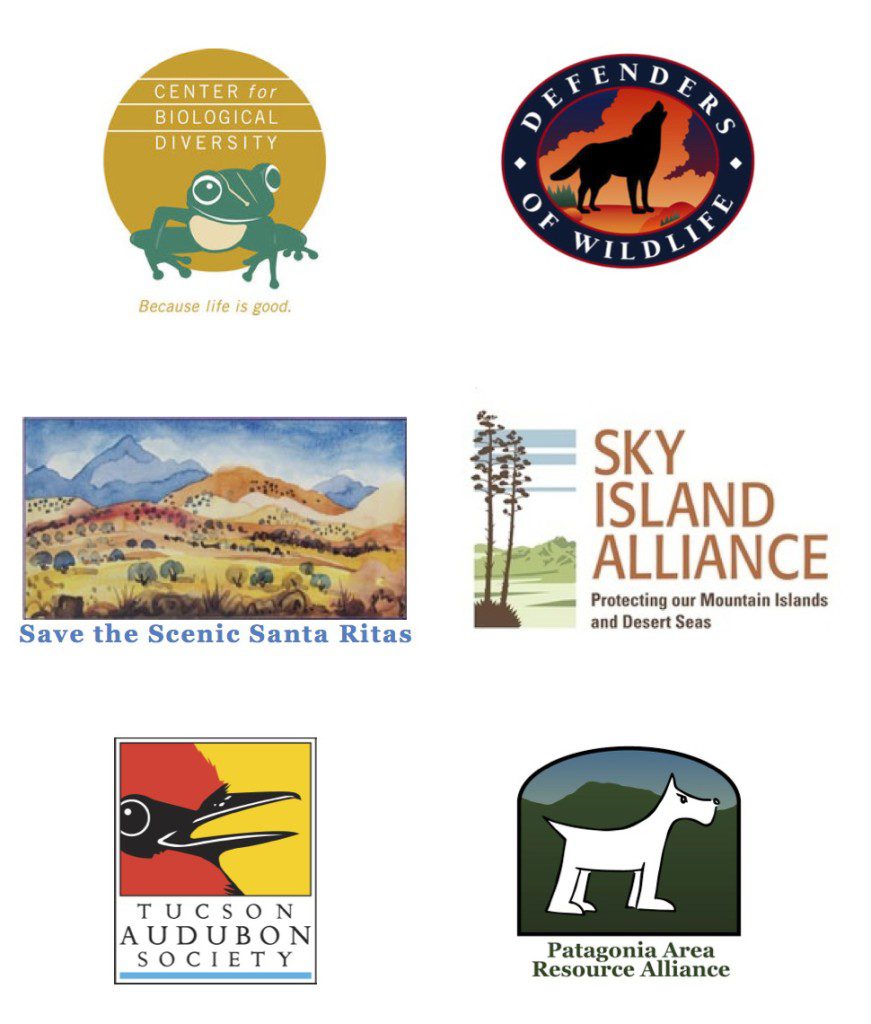

Apr 10, 2015 | Blog
|
|
|
Patagonia EARTHfest Event:
Trails Day • Earth Day • Arbor Day
A celebration of our biological diversity, cultural heritage, and local resiliency in Patagonia, Arizona.
The 6th Annual Patagonia EARTHfest is being held  on Saturday, April 18 in Patagonia, Arizona. Two additional feature presentations on Thursday, April 16 and Friday, April 17. on Saturday, April 18 in Patagonia, Arizona. Two additional feature presentations on Thursday, April 16 and Friday, April 17.
This year’s event theme is TREES.
The Patagonia Area Resource Alliance will be hosting a booth at Cady Hall for all the latest information on area mining (in)activity.
Follow link for full schedule of EARTHfest Guided Walks • Workshops • Youth Activities • Family Fun
Or follow the EARTHfest Facebook Page: facebook.com/EarthFestPatagoniaAZ |
|
|
Save the Date: Saturday, May 9, 2015
|

|
|
Kevin Pakulis Benefit Concert for Friends of the Mountain Empire
Join us for a very special evening of music with the Kevin Pakulis Band on Saturday, May 9 at 7pm in Copper Hall at Hotel Congress, Tucson.
Special guest appearance by Congressman Raúl Grijalva.
Support the organizations working to protect and preserve the habitat, water, and wildlife of the Mountain Empire from new mining in the Patagonia Mountains, Santa Rita Mountains, Canelo Hills and the San Rafael Valley of southern Arizona.
Center for Biological Diversity | Defenders of Wildlife | Save the Scenic Santa Ritas | Sky Island Alliance | Tucson Audubon Society | Patagonia Area Resource Alliance.
Additional thanks to Hotel Congress for helping us host an evening of information, inspiration, and MUSIC in their beautiful Copper Hall. |
|
|
|
|
|
|
|
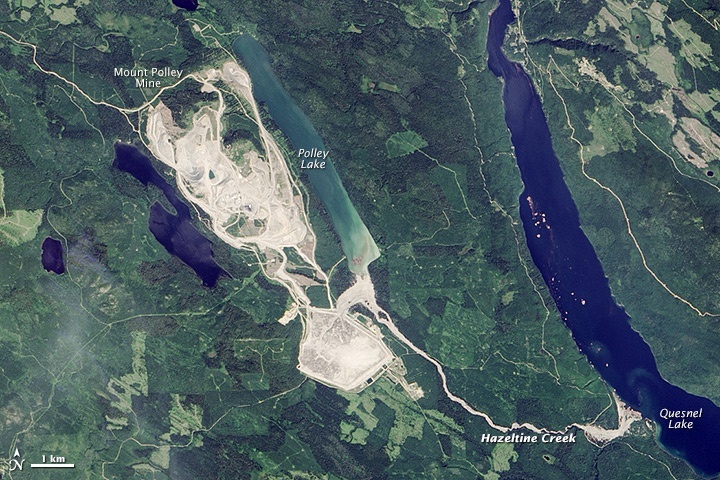
Mar 19, 2015 | Blog
EARTHWORKS PRESS RELEASE
Letter from community and enviro groups around the country urges EPA, Forest Service, BLM to respond to lessons of Mount Polley mine disaster findings
A coalition of more than 40 environmental and community groups today sent letters to the U.S.Environmental Protection Agency (EPA), Bureau of Land Management (BLM), and U.S. Forest Service (USFS) urging they take immediate action to investigate threats posed by mine waste dams and impoundments in the United States.
In the wake of the August 2014 Mount Polley mine waste disaster in Canada which released roughly 24.4 million cubic meters of mine waste into the Fraser River watershed, a government-commissioned independent investigative panel determined that current global standard practice for mine waste disposal is fundamentally flawed and that future failures at other mines are simply a matter of time. To date, U.S. regulators have taken no action to assess the risks posed by mines in the U.S.

Aerial view of the earthen dam at Mount Polley Mine in British Columbia that breached on August 4, 2014, sending contaminated water into nearby lakes.
“The most important finding of the Mount Polley investigation is that catastrophic mine waste dam failures can and will happen anywhere, unless we apply the lessons of Mount Polley and act to prevent them,” said Dr. David Chambers, president of the Center for Science in Public Participation. He continued, “Preventing these failures is critical to protecting the public from environmental and financial impacts, since there is no financial surety for catastrophic tailings dam accidents.”
“The best available science now warns that business as usual at modern mines means more mine waste catastrophes. That’s unacceptable,” said Jennifer Krill, Executive Director of Earthworks. “To protect clean water, communities and the environment, we need regulators in the United States to act on the lessons learned from the Mount Polley disaster.”
The government-commissioned, independent investigation into the Mount Polley dam failure concluded that the dam design was at fault, and predicted that an estimated 2 additional tailings dam failures could occur every 10 years in British Columbia if business continues as usual.
There are 839 tailings dams in the United States according the U.S Army Corps of Engineers. Mining companies worldwide use Knight-Piésold, the engineering firm that designed and built the tailings dam that failed at Mount Polley — including at the proposed Pebble copper-gold mine in the watershed of Alaska’s Bristol Bay.
Large tailings dams built to contain mining waste, among the largest structures in the world, must stand in perpetuity. Yet there is no federal agency in the U.S., nor global entity, responsible for oversight of tailings dam safety. The few tailings dam safety and construction requirements that exist were developed from those intended for water retention dams, not for mine tailings dams.
Farther south, the Mount Polley disaster has spurred worries about a proposed silver mine on U.S. Forest Service land only about 7 miles upstream of the tourist town of Patagonia, Arizona.
“Our town’s entire water supply is from groundwater, and the tailings dam would feed into the creek running through the town,” Coordinator Wendy Russell of the Patagonia Area Resource Alliance. “We already have acid leaks from historical mines,” she said. “We don’t need a Mount Polley here.”
FOR MORE INFORMATION





 Rob Peters, Senior Representative, Southwest Office
Rob Peters, Senior Representative, Southwest Office


 Release Date: Sep 1, 2016
Release Date: Sep 1, 2016 On or about August 9, a short-duration, high-intensity precipitation event on the order of a five- year event (based on National Oceanic and Atmospheric Administration point precipitation frequency estimates, and radar data) passed through the area, resulting in damage to the completed work.
On or about August 9, a short-duration, high-intensity precipitation event on the order of a five- year event (based on National Oceanic and Atmospheric Administration point precipitation frequency estimates, and radar data) passed through the area, resulting in damage to the completed work.

































